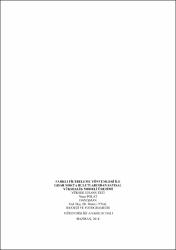| dc.contributor.advisor | Uysal, Murat | |
| dc.contributor.author | Polat, Nizar | |
| dc.date.accessioned | 2019-05-27T10:43:36Z | |
| dc.date.available | 2019-05-27T10:43:36Z | |
| dc.date.issued | 2014 | |
| dc.identifier.uri | http://hdl.handle.net/11630/6200 | |
| dc.description | Digital Elevation Model (DEM) and Digital Terrain Model (DTM) are important topographic products and essential demands for many applications. Traditional methods for creating DEM and DTM are very costly and time consuming because of land surveying. In time, photogrammetry has become the first methods to generate DTM. Recently, airborne Light Detection and Ranging (LiDAR) system has become a powerful way to produce a DEM or DTM due to advantage of collecting three-dimensional information over a large area very effectively by means of precision and time. Airborne LiDAR collects information about not only from land surface but also from every object between plane and terrain that can reflect the laser beam. So filtering out nonground points from raw point clouds is the major step of DEM and DTM generation.
DEM and DTM generation from LiDAR point cloud is not fully automation. There are lots of different filtering algorithm due to several factors affect the filtering prosedures. These algorithms are working in different accuracy for different topographical areas. Because of topographical features is established based algorithms are not applicable to every land.
DTM can be produced by different interpolation methods of the filtered data. However, filtering results directly affect the interpolation results. Because each interpolation method, create the model starting from the data set that is filtered. That's why filtering errors is also available in created DTM.
DEM and DTM generated from filtered airborne LiDAR data are sensitive enough to be used as a base model for many projects. Nevertheless airborne LiDAR system's own inherent sensitivity and filtering caused outliers still affect results. New filtering algorithms can be developed and and different data types may also be included to filter for improving the results. | en_US |
| dc.description.abstract | Sayısal yükseklik modeli (SYM) ve sayısal arazi modeli (SAM) birçok mühendislik uygulaması ve analiz için temel teşkil eden çok önemli topografik ürünlerdir. Bu modellerin üretimi için veri toplama şekilleri gelişen teknolojiye paralel olarak değişmektedir. Son yıllarda hava lazer tarama sistemleri veri toplanması konusunda önem kazanmıştır. Hava lazer tarama sistemleri sonucu elde edilen üç boyutlu nokta bulutu SYM ve SAM üretimi için kullanılabilmektedir. Ancak lazer taraması esnasında sadece yer noktaları değil doğal ve yapay tüm objelerde veri setine dâhil olmaktadır. Bu yüzden ham nokta bulutunun SYM ve SAM üretiminden önce filtrelenmesi gerekmektedir. SYM ve SAM üretimindeki en büyük problem veri filtrelemedir.
Airborne Light Detection and Ranging (hava LiDAR) verilerinden SYM ve SAM üretiminde henüz tam otomasyon sistemi oluşmuş değildir. Birçok parametreye ve ön bilgiye bağımlı olan filtreleme işlemi için farklı algoritmalar ve yazılımlar geliştirilmiştir. Bu algoritmalar farklı topografik alanlar için farklı doğruluklarda çalışmaktadırlar. Çünkü algoritmaların temelini oluşturan topografik özellikler her arazi için geçerli değildir.
Filtrelenmiş verilerden farklı enterpolasyon yöntemleri ile SAM üretilebilir. Fakat filtreleme sonuçları enterpolasyon sonuçlarını doğrudan etkilemektedir. Çünkü her enterpolasyon yöntemi kullandığı veri setinden yola çıkarak modeli oluşturur. Bu nedenle filtrelemeden kaynaklanan hatalar oluşturulan SAM’ da mevcuttur.
Hava LiDAR verilerinde SYM ve SAM üretimi için ücretsiz yapılan filtreleme sonuçları birçok projede altlık olarak kullanılabilecek hassasiyettedir. Fakat hava LiDAR teknolojisinin sistem duyarlılığı ve filtrelemeden kaynaklanan aykırı değerler hala sonuçlara etki etmektedir. Sonuçların iyileştirilmesi için yeni filtreleme algoritmaları geliştirilebilir ve farklı veri tipleri de filtrelemeye dâhil edilebilir. | en_US |
| dc.language.iso | tur | en_US |
| dc.rights | info:eu-repo/semantics/openAccess | en_US |
| dc.subject | LiDAR, Filtreleme, SYM, SAM | en_US |
| dc.title | Farklı Filtreleme Yöntemleri ile Lidar Nokta Bulutlarından Sayısal Yükseklik Modeli Üretimi | en_US |
| dc.title.alternative | Dıgıtal Elevatıon Model (Dem) Generatıon with Lidar Poınt Cloud Fıltered by Dıfferent Algorıthms | en_US |
| dc.type | masterThesis | en_US |
| dc.identifier.startpage | 1 | en_US |
| dc.identifier.endpage | 64 | en_US |
| dc.relation.publicationcategory | Tez | en_US |



















